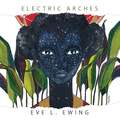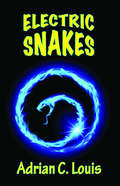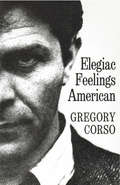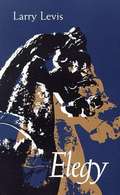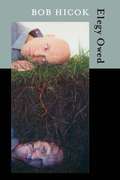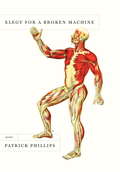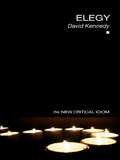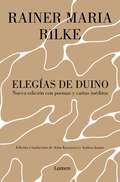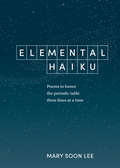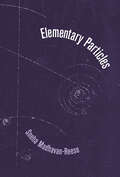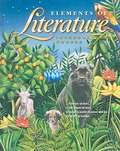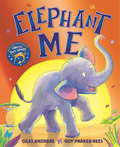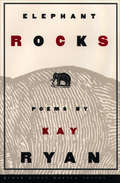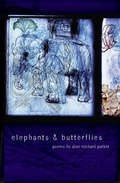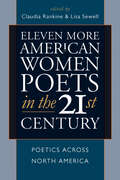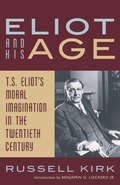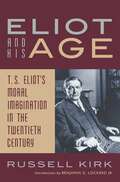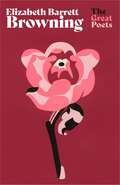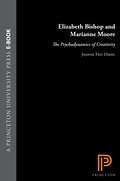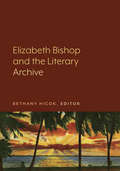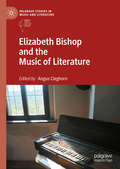- Table View
- List View
Electric Arches
by Eve L. EwingElectric Arches is an imaginative exploration of Black girlhood and womanhood through poetry, visual art, and narrative prose. <p><p> Blending stark realism with the surreal and fantastic, Eve L. Ewing's narrative takes us from the streets of 1990s Chicago to an unspecified future, deftly navigating the boundaries of space, time, and reality. Ewing imagines familiar figures in magical circumstances--blues legend Koko Taylor is a tall-tale hero; LeBron James travels through time and encounters his teenage self. She identifies everyday objects--hair moisturizer, a spiral notebook--as precious icons. <p> Her visual art is spare, playful, and poignant--a cereal box decoder ring that allows the wearer to understand what Black girls are saying; a teacher's angry, subversive message scrawled on the chalkboard. Electric Arches invites fresh conversations about race, gender, the city, identity, and the joy and pain of growing up.
Electric Snakes
by Adrian C. Louis"In ELECTRIC SNAKES, Adrian C. Louis's thirteenth poetry collection, no one is spared his critical eye, including himself. These powerful and often humorous poems cover myriad subjects: Trump, music, zombies, Jimmy John's, childhood, caller ID, venetian blinds, magpies, love, and Mom."—From the Editor
Elegguas (The Driftless Series)
by Kamau BrathwaiteKamau Brathwaite is a major Caribbean poet of his generation and one of the major world poets of the second half of the twentieth century. Elegguas—a play on "elegy" and "Eleggua," the Yoruba deity of the threshold, doorway, and crossroad—is a collection of poems for the departed. Modernist and post-modernist in inspiration, Elegguas draws together traditions of speaking with the dead, from Rilke's Duino Elegies to the Jamaican kumina practice of bringing down spirits of the dead to briefly inhabit the bodies of the faithful, so that the ancestors may provide spiritual assistance and advice to those here on earth. The book is also profoundly political, including elegies for assassinated revolutionaries like in the masterful "Poem for Walter Rodney."Throughout his poetry, Brathwaite foregrounds "nation-language," that difference in syntax, in rhythm, and timbre that is most closely allied to the African experience in the Caribbean, using the computer to explore the graphic rendition of nuances of language. Brathwaite experiments using his own Sycorax fonts, as well as deliberate misspellings ("calibanisms") and deviations in punctuation. But this is never simple surface aesthetic, rather an expression of the turbulence (in history, in dream) depicted in the poems. This collection is a stunning follow-up to Brathwaite's Born to Slow Horses (Wesleyan, 2005), winner of the Griffin International Poetry Prize.
Elegiac Feelings American: Poetry
by Gregory CorsoA collection of poems by the renowned Beat poet, Gregory Corso. Gregory Corso's collection of poems contains works of major proportions. The title poem is a tribute to Jack Kerouac, fusing a memorial to the poet's dead friend with a bitter lament for the present state of America. The second major work, "The Geometric Poem," published previously in a limited edition by Fernanda Pivano in Italy, is a complex visionary restatement of themes from ancient Egyptian religion. Reproduced in facsimile from Corso's handwritten sheets, his marginal decorations, drawings and glyphs are included. The balance of the book is drawn from his shorter poems. Corso's reputation as a leading poet and co-founder of the Beat movement is clearly upheld in these poems. His instinct for integrated lyrical statement, his special contribution to Beat poetry, is as strong as ever; his sense of humor and sexuality have not diminished. But he has added a wider-ranging moral urgency and a new depth of humane solicitude that hold even his strangest visions close to the heart of contemporary feeling.
Elegy
by Larry LevisA few days before his death in 1996, Larry Levis mentioned to his friend and former instructor Philip Levine that he had "an all-but-completed manuscript" of poems. Levine had years earlier recognized Levis as "the most gifted and determined young poet I have ever had the good fortune to have in one of my classes"; after Levis's death, Levine edited the poems Levis had left behind. What emerged is this haunting collection, Elegy. The poems were written in the six years following publication of his previous book, The Widening Spell of the Leaves, and continue and extend the jazz improvisations on themes that gave those poems their resonance. There are poems of sudden stops and threats from the wild: an opossum halts traffic and snaps at pedestrians in posh west Los Angeles; a migrant worker falls victim to the bites of two beautiful black widow spiders; horses starve during a Russian famine; a thief, sitting in the rigging of Columbus's ship, contemplates his work in the New World. The collection culminates in the elegies written to a world in which culture fragments; in which the beasts of burden-the horses, the migrant workers-are worked toward death; a world in which "Love's an immigrant, it shows itself in its work. / It works for almost nothing"; a world in which "you were no longer permitted to know, / Or to decide for yourself, / Whether there was an angel inside you, or whether there wasn't. " Elegy, as Levine says, was "written by one of our essential poets at the very height of his powers. His early death is a staggering loss for our poetry, but what he left is a major achievement that will enrich our lives. "
Elegy Owed
by Bob Hicok"Smart, honest, powerfully inventive, [Hicok's] writing asks the biggest questions while acknowledging that there are no answers beyond the imposed structure of the page."-Los Angeles Times"Seamlessly, miraculously, [Hicok's] judicious eye imbues even the dreadful with beauty and meaning."-The New York Times Book ReviewGritty, complicated, and earnest, Elegy Owed breaks-then salvages-the rules for mourning. While poet Bob Hicok remembers the departed as ephemera or skin cells, fog is invited to tea and the beauty of dandelion fluff is held for ransom. Hicok's language is so humid with expectation and fearlessness that his poems create a clandestine manual to survival.From "The Order of Things":Then I stopped hearing from you. Then I thoughtI was Beethoven's cochlear implant. Then I listenedto deafness. Then I tacked a whisperto the bulletin board. Then I liked dandelionsbest in their afro stage. Then a breezeheld their soft beauty for ransom. Then no onethrows a Molotov cocktail betterthan a Buddhist monk...Bob Hicok is one of the most active poets writing today, and his poems have appeared widely, including in The New Yorker and Poetry. His honors include the Bobbitt Prize from the Library of Congress and a "Notable Book of the Year" from Booklist. Hicok has worked as an automotive die designer and a computer system administrator, and is currently an associate professor of English at Virginia Tech. He lives in Blacksburg, Virginia.
Elegy for a Broken Machine
by Patrick PhillipsThe poet Patrick Phillips brings us a stunning third collection that is at its core a son's lament for his father. This book of elegies takes us from the luminous world of childhood to the fluorescent glare of operating rooms and recovery wards, and into the twilight lives of those who must go on. In one poem Phillips watches his sons play "Mercy" just as he did with his brother: hands laced, the stronger pushing the other back until he grunts for mercy, "a game we played // so many times / I finally taught my sons, // not knowing what it was, / until too late, I'd done." Phillips documents the unsung joys of midlife, the betrayals of the human body, and his realization that as the crowd of ghosts grows, we take our places, next in line. The result is a twenty-first-century memento mori, fashioned not just from loss but also from praise, and a fierce love for the world in all its ruined splendor.From the Hardcover edition.
Elegy: Poetry, Elegy, Walking, Spirit (The New Critical Idiom)
by David KennedyGrief and mourning are generally considered to be private, yet universal instincts. But in a media age of televised funerals and visible bereavement, elegies are increasingly significant and open to public scrutiny. Providing an overview of the history of the term and the different ways in which it is used, David Kennedy: outlines the origins of elegy, and the characteristics of the genre examines the psychology and cultural background underlying works of mourning explores how the modern elegy has evolved, and how it differs from ‘canonical elegy’, also looking at female elegists and feminist readings considers the elegy in the light of writing by theorists such as Jacques Derrida and Catherine Waldby looks at the elegy in contemporary writing, and particularly at how it has emerged and been adapted as a response to terrorist attacks such as 9/11. Emphasising and explaining the significance of elegy today, this illuminating guide to an emotive literary genre will be of interest to students of literature, media and culture.
Elegías de Duino, seguido de cartas y poemas inéditos: Edición especial del centenario
by Rainer Maria Rilke100 AÑOS DE UN CLÁSICO La edición definitiva de la obra maestra de Rilke, en una nueva traducción que incluye cartas y poemas inéditos «De vez en cuando ocurre el milagro: el escritor delicado, dubitativo y con tendencia ansiosa se retira, y a través de él resuena la música del universo: como la base de una fuente, hace tanto de oído como de instrumento».Hermann Hesse En 1923 vieron la luz las Elegías de Duino, uno de los ciclos poéticos más influyentes del siglo XX. Rainer Maria Rilke había empezado a escribirlo diez años antes, una década en la que el mundo cambió de forma vertiginosa. Las elegías dan vueltas a todo lo que estaba desapareciendo en un entorno cada vez más tecnificado: el sentido de la trascendencia, el amor más profundo y radical, la condición efímera del ser humano. Este volumen incluye, además de una nueva traducción a cargo de Adan Kovacsics y Andreu Jaume, los poemas que Rilke escribió en aquella época sobre la misma temática y una selección de cartas sobre la gestación de la obra. Todo esto la convierte en la edición más completa, ambiciosa y rigurosa que se ha hecho en castellano de este clásico de las letras europeas. La crítica ha dicho:«El último gran lírico europeo de la edad clásica».Félix de Azúa «Este gran lírico no ha hecho más que llevar a la perfección el poema alemán por primera vez; no fue una cumbre de esta época, fue una de esas alturas en las que el destino del espíritu hace pie para pasar sobre las épocas [...]. Su filiación es la de los siglos de la literatura alemana, no la de la actualidad».Robert Musil «Las Elegías de Duino constituyen el último residuo de la religiosidad, la última forma literaria de la certificación de lo religioso».Hannah Arendt «Aún no estamos preparados para interpretar las Elegías y los Sonetos de Rilke».Martin Heidegger «Hay una espera silenciosa de la palabra inspirada. Así, Rilke nos hace ver los largos momentos de recogimiento y de elocuencia difusa y, si se quiere, desatinada que culminaron después en las grandes Elegías».Álvaro Pombo «Leer las Elegías de Duino es sentir que el pensamiento se ha hecho rezo; las palabras, música; el poeta y el lector, una sola persona».Michael Dirda, The Washington Post «Si la palabra "magia" significa algo, he de decir que todo Rilke, su voz, su apariencia, sus modales, todo sobre él daba la impresión de una presencia mágica. Rilke le otorgaba a cada palabra, una vez pronunciada, el poder de un encantamiento».Paul Valéry «Rilke es el primer poeta desde el siglo XVII en encontrar una solución fresca».W. H. Auden
Elemental Haiku: Poems to honor the periodic table, three lines at a time
by Mary Soon LeeA fascinating little illustrated series of 118 haiku about the Periodic Table of Elements, one for each element, plus a closing haiku for element 119 (not yet synthesized). Originally appearing in Science magazine, this gifty collection of haiku inspired by the periodic table of elements features all-new poems paired with original and imaginative line illustrations drawn from the natural world. Packed with wit, whimsy, and real science cred, each haiku celebrates the cosmic poetry behind each element, while accompanying notes reveal the fascinating facts that inform it. Award-winning poet Mary Soon Lee's haiku encompass astronomy, biology, chemistry, history, and physics, such as "Nickel, Ni: Forged in fusion's fire,/flung out from supernovae./Demoted to coins." Line by line, Elemental Haiku makes the mysteries of the universe's elements accessible to all.
Elementary Particles
by Sneha Madhavan-ReesePart family history, part scientific exploration, Elementary Particles examines the world through the lens of a daughter grieving the loss of her beloved father. Through keen, quiet observation, Sneha Madhavan-Reese's evocative new collection takes us from the wide expanse of rural India to the minute map of Michigan we carry on the palms of our hands. These poems contemplate ancestral language, the wonder and uncertainty of scientific discovery, the resilience of a dung beetle, the fleeting existence of frost flowers on the Arctic Ocean. The collection is full of familiar characters, from Rosa Parks to Seamus Heaney to Corporal Nathan Cirillo, anchoring it in specific moments in time and place, but has the universality that comes from exploring the complex relationship between a child and her immigrant parents, and in turn, a mother and her children. Elementary Particles examines the building blocks of a life — the personal, family, and planetary histories, transformations, and losses we all experience.
Elements of Literature: Introductory Course
by Holt Rinehart WinstonThis Elements of Literature-Introductory Course has a collection of short stories, fairy tales, novels, plays, poems, magazine articles, Essays, autobiographies, biographies, true narratives, interviews, communication workshops etc.
Elephant Me
by Giles AndreaeThe empowering story of little elephant Num-Num, who discovers the importance of simply being YOU! From the creators of international bestseller and much-loved classic Giraffes Can't Dance.It's time for the Elephant Games! One by one, the young elephants compete to impress King Elephant Mighty and earn their Elephant Name. Nina is the strongest, so she becomes Elephant Strong. Norcus is the loudest, so he becomes Elephant Noisy. Little Elephant Num-Num thinks he will never discover his own special talent - until he learns that the very best thing you can be is YOU!Giraffes Can't Dance has been a much-loved family favourite for over 20 years, and has sold over 7 million copies worldwide.
Elephant Rocks: Poems (Books That Changed the World)
by Kay RyanThe former US Poet Laureate shares &“fine poems that inspire us with poetry&’s greatest gifts: the music of language and the force of wisdom&” (Annie Dillard, Pulitzer Prize–winning author). Elephant Rocks, Kay Ryan&’s third book of verse, shows a virtuoso practitioner at the top of her form. Engaging and secretive, provocative and profound, Ryan&’s poems have generated growing excitement with their appearances in The New Yorker and other leading periodicals. Sometimes gaudily ornamental, sometimes Shaker-plain, here is verse that is compact on the page and expansive in the mind. &“Kay Ryan makes it all fresh again with her highly original vision, her elegant, quirky craft. These poems look easy, but the deeper one delves, the more they astonish and astound.&” —May Sarton, New York Times–bestselling author of At Eighty-Two &“Kay Ryan works toward an exciting art, much less sparse than it looks. This is natural history seen from an angle of vision that Emerson and Dickinson would have approved. It refreshes me to find poems that require and reward rereading as much as these do.&” —Harold Bloom, literary critic and author of The Bright Book of Life &“The music of these poems is every bit as seductive as their reasoning. Her thinking flaunts the plush, irresistible textures of organic growth . . . Marvelous.&” —Boston Review &“These poems show a poet who is terribly sly in her reckoning of our world.&” —David St. John, author of The Last Troubadour: New and Selected Poems &“So original, so astute, so pleasurable are the poems in this book, it wouldn&’t be at all surprising if they&’re still being read long after current critical fashions are dated.&” —Poetry
Elephants & Butterflies (American Poets Continuum #111)
by Alan Michael ParkerElephants & Butterflies combines the imaginative forays of The Vandals with the more meditative approach of Love Song with Motor Vehicles. Both wild and calm, boisterous and quiet, the poems in Elephants & Butterflies use surprise, song, and startling metaphor while allowing the ideas to simmer just below the surface of the lyric. The poems manage the difficult task of being highly readable and accessible, while still containing complex philosophical and personal knowledge.Alan Michael Parker (www.amparker.com) teaches at Davidson College in Davidson, North Carolina. He also teaches at Queens University, where he is core faculty in the low-residency MFA program.
Eleven More American Women Poets in the 21st Century: Poetics across North America (American Poets in the 21st Century)
by Lisa Sewell Claudia RankineEleven More American Women Poets in the 21st Century is an exciting sequel to its predecessors in the American Poets in the 21st Century series. Like the earlier anthologies, this volume includes generous selections of poetry by some of the best poets of our time as well as illuminating poetics statements and incisive essays on their work. This unique organization makes these books invaluable teaching tools. Broadening the lens through which we look at contemporary poetry, this new volume extends its geographical net by including Caribbean and Canadian poets. Representing three generations of women writers, among the insightful pieces included in this volume are essays by Karla Kelsey on Mary Jo Bang's modes of artifice, Christine Hume on Carla Harryman's kinds of listening, Dawn Lundy Martin on M. NourbeSe Phillip (for whom "english / is a foreign anguish"), and Sina Queyras on Lisa Robertson's confoundingly beautiful surfaces. A companion web site will present audio of each poet's work.
Eliot and His Age: T. S. Eliot's Moral Imagination in the Twentieth Century
by Russell KirkEliot and His Age remains the best introduction to T. S. Eliot’s life, ideas, and literary works. It is the essential starting place for anyone who would understand what Eliot was about. Russell Kirk’s view of his older friend is sympathetic but not adulatory. His insights into Eliot’s writings are informed by wide reading in the same authors who most influenced the poet, as well as by similar experiences and convictions.Kirk elaborates here a significant theory of literary meaning in general, showing how great literary works awaken our intuitive reason, giving us profound visions of truth that transcend logical processes. And he traces Eliot’s political and cultural ideas to their true sources, showing the balance and subtlety of Eliot’s views. Eliot and His Age is a literary biography that will endure when much of the more recent writing on Eliot is gathering dust.
Eliot and His Age: T. S. Eliot's Moral Imagination in the Twentieth Century
by Russell KirkThough much has been written about T. S. Eliot since it was first published, Eliot and His Age remains the best introduction to the poet's life, ideas, and literary works. It is the essential starting place for anyone who would understand what Eliot was about. Russell Kirk's view of his older friend is sympathetic but not adulatory. His insights into Eliot's writings are informed by wide reading in the same authors who most influenced the poet, as well as by similar experiences and convictions. Kirk elaborates here a significant theory of literary meaning in general, showing how great literary works awaken our intuitive reason, giving us profound visions of truth that transcend logical processes. And he traces Eliot's political and cultural ideas to their true sources, showing the balance and subtlety of Eliot's views. Eliot and His Age is a literary biography that will endure when much of the more recent writing on Eliot is gathering dust.
Elizabeth Barrett Browning: Much-loved poems from one of the greatest Romantic poets (The Great Poets)
by Elizabeth Barrett Browning'How do I love thee? Let me count the ways'Elizabeth Barrett Browning was a poet of passion, wit and conscience. She was also a woman who wrote to speak the truth about everything she knew - and she knew just what it was like to be a thinking woman in a society that wanted women to be weak. The eldest of twelve children, she wrote poetry from the age of eleven, and became a highly successful poet in her lifetime - and remains very much loved today.She was also a strong advocate for human rights, campaigning to abolish slavery and child labour, and her three-part poem A Curse for a Nation is a powerful polemic against the slave trade.'I heard an angel speak last night, and he said "write! Write a nation's curse for me, and send it over the western sea" '
Elizabeth Barrett Browning: Much-loved poems from one of the greatest Romantic poets (The Great Poets)
by Elizabeth Barrett Browning'How do I love thee? Let me count the ways'Elizabeth Barrett Browning was a poet of passion, wit and conscience. She was also a woman who wrote to speak the truth about everything she knew - and she knew just what it was like to be a thinking woman in a society that wanted women to be weak. The eldest of twelve children, she wrote poetry from the age of eleven, and became a highly successful poet in her lifetime - and remains very much loved today.She was also a strong advocate for human rights, campaigning to abolish slavery and child labour, and her three-part poem A Curse for a Nation is a powerful polemic against the slave trade.'I heard an angel speak last night, and he said "write! Write a nation's curse for me, and send it over the western sea" '
Elizabeth Bishop and Marianne Moore: The Psychodynamics of Creativity
by Joanne Feit DiehlThis highly innovative work on poetic influence among women writers focuses on the relationship between modernist poet Elizabeth Bishop and her mentor Marianne Moore. Departing from Freudian models of influence theory that ignore the question of maternal presence, Joanne Diehl applies the psychoanalytic insights of object relations theorists Melanie Klein and Christopher Bollas to woman-to-woman literary transactions. She lays the groundwork for a far-reaching critical approach as she shows that Bishop, mourning her separation from her natural mother, strives to balance gratitude toward Moore, her literary mother, with a potentially disabling envy.Diehl begins by exploring Bishop's memoir of Moore, "Efforts of Affection," as an attempt by Bishop to verify Moore's uniqueness in order to defend herself against her predecessor's almost overwhelming originality. She then offers an intertextual reading of the two writers' works that inquires into Bishop's ambivalence toward Moore. In an analysis of "Crusoe in England" and "In the Village," Diehl exposes the restorative impulses that fuel aesthetic creation and investigates how Bishop thematizes an understanding of literary production as a process of psychic compensation.
Elizabeth Bishop and the Literary Archive
by Bethany HicokIn a life full of chaos and travel, Elizabeth Bishop managed to preserve and even partially catalog, a large collection—more than 3,500 pages of drafts of poems and prose, notebooks, memorabilia, artwork, hundreds of letters to major poets and writers, and thousands of books—now housed at Vassar College. Informed by archival theory and practice, as well as a deep appreciation of Bishop’s poetics, the collection charts new territory for teaching and reading American poetry at the intersection of the institutional archive, literary study, the liberal arts college, and the digital humanities. The fifteen essays in this collection use this archive as a subject, and, for the first time, argue for the critical importance of working with and describing original documents in order to understand the relationship between this most archival of poets and her own archive. This collection features a unique set of interdisciplinary scholars, archivists, translators, and poets, who approach the archive collaboratively and from multiple perspectives. The contributions explore remarkable new acquisitions, such as Bishop’s letters to her psychoanalyst, one of the most detailed psychosexual memoirs of any twentieth century poet and the exuberant correspondence with her final partner, Alice Methfessel, an important series of queer love letters of the 20th century. Lever Press’s digital environment allows the contributors to present some of the visual experience of the archive, such as Bishop’s extraordinary “multi-medial” and “multimodal” notebooks, in order to reveal aspects of the poet’s complex composition process.
Elizabeth Bishop and the Music of Literature (Palgrave Studies in Music and Literature)
by Angus CleghornElizabeth Bishop and the Music of Literature brings together the latest understandings of how central music was to Bishop’s writing. This collection considers Bishop’s reworking of metrical and rhythmic forms of poetry; the increasing presence of prosaic utterances into speech-soundscapes; how musical poetry intones new modes of thinking through aural vision; how Bishop transforms traditionally distasteful tones of violence, banality, and commerce into innovative poetry; how her diverse, lifelong musical education (North American, European, Brazilian) affects her work; and also how her diverse musical settings have inspired global contemporary composers. The essays flesh out the missing elements of music, sound, and voice in previous research that are crucial to understanding how Bishop’s writing continues to dazzle readers and inspire artists in surprising ways.
Elizabeth Bishop at Work
by Eleanor CookCritics and biographers praise Elizabeth Bishop's poetry but have little to say about how it does its sublime work--in the ear and in the mind's eye. Eleanor Cook examines in detail Bishop's diction, syntax, rhythm, and meter, her acute sense of place, and her attention to the natural world. Writers, readers, and teachers will all benefit.
